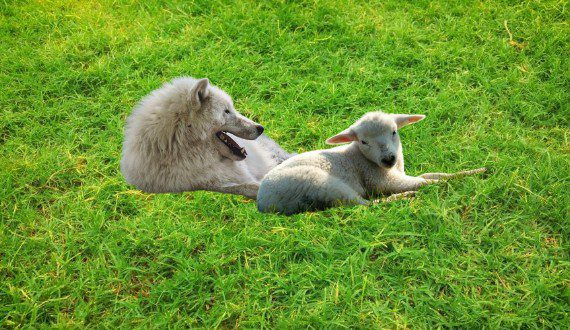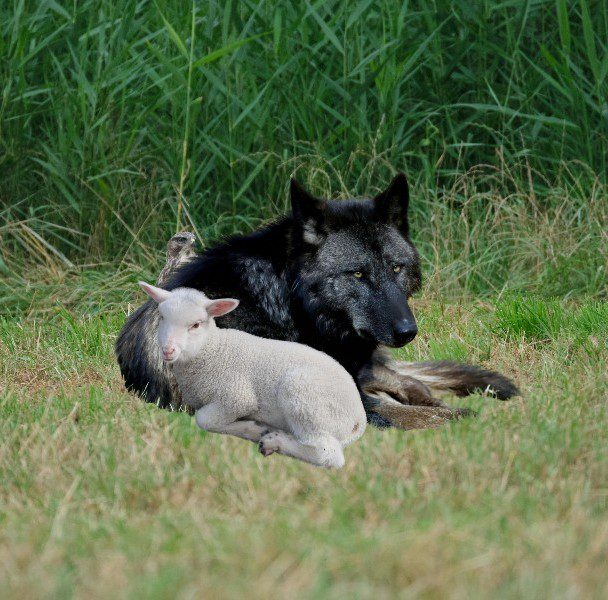Wolves are Laying with Lambs

Many Christians believe that the “wolf laying with the lamb†is still future event. However, the Scriptural evidence shows it has been fulfilled.
“6 The wolf also shall dwell with the lamb, the leopard shall lie down with the young goat, the calf and the young lion and the fatling together. 7 The cow and the bear shall graze; their young ones shall lie down together; and the lion shall eat straw like the ox. 8 The nursing child shall play by the cobra’s hole, and the weaned child shall put his hand in the viper’s den. 9 They shall not hurt nor destroy in all My holy mountain, for the earth shall be full of the knowledge of the Lord As the waters cover the sea. 10 ‘And in that day there shall be a Root of Jesse, who shall stand as a banner to the people; for the Gentiles shall seek Him’†(Isa. 11:6–10, bolding mine).
Notice how Isaiah said all these events would happen “in the same dayâ€â€”that is, in the same generation. Moreover, the New Testament affirms that “the Root of Jesse standing as a banner to the people†and “the Gentiles coming to the Lord†(v. 10) happened in the first century. Therefore, the other events must have happened then too.
The “branch from the root of Jesse†refers to Jesus, who came from Jesse’s lineage. Jesse fathered David, and Jesus came through David’s lineage (cf. Matt. 1:1–16 and Isa. 11:1).
The apostle Paul quoted this Isaiah passage, too, because it was being fulfilled during his ministry: “‘Rejoice, O Gentiles, with His people!’ And again: ‘Praise the Lord, all you Gentiles! Laud Him, all you peoples!’ And again, Isaiah says: ‘There shall be a root of Jesse; And He who shall rise to reign over the Gentiles, In Him the Gentiles shall hope’†(Rom. 15:9–12; see also Eph. 2:11–15, 3:3–6). The reason Paul quoted this passage from Isaiah is because it was finally coming to pass in his day. Gentiles from all over the nations were coming to Jesus.
Since the Gentiles were coming to the Lord, then this is when the “friendly animal†verses must have been fulfilled too. After all, it would all happen “in that day.”
What, then, do these verses refer to? They refer to life in the new covenant age, where Jews and Gentiles—which had traditionally been enemies—would finally get along and worship the God of the Bible together.
Hosea prophesied about this time period, as well, using the same “friendly animal†descriptions: “In that day I [God] will make a [new] covenant for them, with the beasts of the field, with the birds of the air, and with the creeping things of the ground†(Hos. 2:18). This was a prophecy about the new covenant age, when God would make a new covenant with the birds of the air and the beasts of the fields…that is, with Jews and Gentiles alike.

Jesus used these same kinds of animal descriptions. For example, Jesus told his disciples, “I send you out as sheep among wolves†(Matt. 10:16). The “sheep†represent God’s people, Israel, and the “wolves†represent Gentiles, who had traditionally been enemies of Israel. Jesus broke down the middle wall of separation between Jews and Gentiles, creating “one new man from the two†(Eph. 2:14–15). Today, Gentiles are fellow heirs with Jews, and partakers of God’s promises (Eph. 3:3–6). In Christ, there is neither Jew nor Gentile (Gal. 3:28). In other words, “the wolves are lying with the lambs.â€
Both the Old and the New Testament repeatedly portray people as animals. God’s people are portrayed as peaceful animals such as sheep, lambs, and doves…and God’s enemies are portrayed as ferocious animals such as leopards, which prey on sheep. Jesus described his followers as sheep and doves, and his enemies as wolves and snakes (Matt. 10:16). Elsewhere, Jesus called his enemies “serpents and a brood of vipers†(Matt. 23:33). Other passages describe the enemies of God as “beasts†(Jude 10, Rev. 13:18).
In fact, Daniel described four beasts coming up from the sea, three of which looked like a lion, bear, and leopard, and the fourth of which had ferocious teeth and horns (Dan. 7:3). Daniel said these four beasts represent “the kings of the earth†(Dan. 7:17), which Christian scholars readily acknowledge represent the Gentile empires of the Babylonians, Medo-Persians, Greeks, and Romans. The last of these beasts, the Roman Empire, was still around when Revelation was written in around AD 65. John too referred to this beast (Rev. 13:1–2).
Here is another interesting phenomenon regarding “animals†in the Bible. When Israel was obedient to God, the animals around her were tame. However, when Israel was disobedient, the animals became ferocious. These animals represent Israel’s Gentile neighbors (surrounding nations), whom God used to judge Israel when she strayed from him:
“[Because of Israel’s disobedience] a lion from the forest shall slay them, a wolf of the deserts shall destroy them; a leopard will watch over their cities. Everyone who goes out from there shall be torn in pieces, because their transgressions are many; their backslidings have increased…‘Behold, I will bring a nation against you from afar, O house of Israel,’ says the Lord. ‘It is a mighty nation, it is an ancient nation, a nation whose language you do not know, nor can you understand what they say’†(Jer. 5:6, 15).
These wolves and leopards represent Israel’s Gentile neighbors/nations, whom God used to judge Israel in times of rebellion. Leviticus sums this concept up nicely: “Follow my [God’s] decrees and be careful to obey my laws, and you [Israel] will live safely in the land†(Lev. 25:18)…otherwise, I will send ferocious animals—your Gentile neighbors—against you (the last part is commentary).
Animals in the Bible often represent people and nations. So when Isaiah 11:6–9 prophesied about “the wolf lying with the lamb†and “a child playing with a viper,†Isaiah was describing a time when Israel would be at peace with her Gentile neighbors. It would be a time when people from all over the world—even people from nations which had historically been enemies of Israel—would come to Israel’s God in peace. Isaiah was describing life in the new covenant age, where “there is neither Jew nor Greek…for you are all one in Christ Jesus†(Gal. 3:28).
And this is the case today. Today, when people and nations come to Christ, they set aside their differences and become friends. Longtime enemies suddenly become friends. The wolf lies down with the lamb (Isa. 11:6). Swords are beaten into plowshares (Isa. 2:4; see below).

Isaiah 55 is another chapter about life in the new covenant age. Verse 5 begins with a prophecy about Gentiles coming to the Lord (just like in Isaiah 11): “Surely you [God] shall call a nation you do not know [Gentiles], and nations who do not know you shall run to you.†Then, verse 12 says: “The mountains and the hills shall break forth into singing before you, and all the trees of the field shall clap their hands.â€
Now ask yourself a question: Are mountains literally going to sing songs? Are trees literally going to clap their hands? Of course not. This was meant no more literally than “wolves lying with lambs†and “children playing with cobras.†These passages are depicting life in the new covenant age, when Jews and Gentiles would get along because of their common Messiah.
“Friendly animal†language is the opposite of apocalyptic language. The former describes peace and blessings; the latter describes judgment. While the two are polar opposites in terms of what they represent, they are nevertheless similar in one aspect, namely, they are both highly symbolic and figurative. Readers who hyper-literalize either will miss the rich meaning and symbolism intended by the biblical writers.
Isaiah 65:25 is another prophecy about the time period when “the wolf and the lamb shall feed together, [and] the lion shall eat straw like the ox.†Just like in Isaiah 11 and 55, this chapter begins by describing Gentiles coming to the Lord: “I [the Lord] was sought by those who did not ask for Me [Gentiles]; I was found by those who did not seek Me. I said, ‘Here I am, here I am,’ to a nation that was not called by My name†(Isa. 65:1). Isaiah then goes on to describe the new heaven and earth (Isa. 65:17–19)—a.k.a. the new covenant age—and says it would take place “on God’s holy mountain,†a.k.a. Mount Zion (Isa. 65:25). Mount Zion is what the Old Testament prophets all longed for. Moreover, the writer of Hebrews said it arrived:
“But you [first-century Christians] have come to Mount Zion and to the city of the living God, the heavenly Jerusalem, to an innumerable company of angels, to the general assembly and church of the firstborn who are registered in heaven, to God the Judge of all, to the spirits of just men made perfect, to Jesus the Mediator of the new covenant, and to the blood of sprinkling that speaks better things than that of Abel…‘Yet once more I [God] shake not only the earth, but also heaven’†(Heb. 12:22–24, 26).
What Isaiah 65 had prophesied would one day happen finally came to pass in the first century, per the writer of Hebrews. In other words, we today are living in the time period when “wolves [the Gentiles/the nations] are lying down with lambs [Jews/Israel].â€
For more about the topics discussed in this article, get my book The End Is Here: How the New Testament’s Prophecies Were Fulfilled.
By Alex Polyak, Director of The Bible Fulfilled, 9/9/24.
